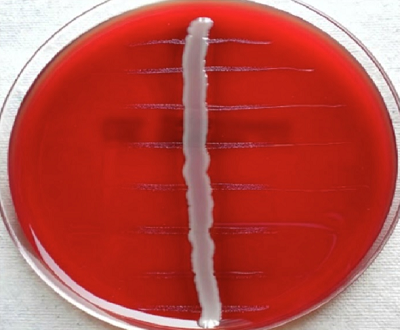Satellitism test - Principle, Characteristics, Purpose, Procedure, Result, Interpretation
Principle of Satellitism test
Most Haemophilus spp. are fastidious and do not grow well on 5% sheep blood agar, which contains X factor (hemin) but lacks V factor (contains nicotinamide-adenine-dinucleotide, NAD; nicotinamide adenine dinucleotide phosphate, NADP).
Staphylococcus aureus, when grown on blood agar, produces β-lysin which lyses RBC present in BA, releasing V factor (NAD). Therefore, around S. aureus colonies where NAD is being released, Haemophilus spp can grow prominently as both X factor (hemin) and V factor (NAD) are freely available.
Colony size decreases as it moves away from the S. aureus streak. This phenomenon is called Satellitism and the test to determine the presence/absence of this phenomenon is called Satellitism test.
Characteristics of Satellitism test
Haemophilus spp. easily grows on chocolate agar (CA) because, in CA, the blood cells are already lyzed by heat, releasing NAD into the medium. So, does not need to depend on hemolytic bacteria such as S. aureus to provide NAD.
However, some organisms give negative satellitism tests although they require hemin and NAD. These microbes including Francisella tularensis, some Methylobacterium, and Haemophilus ducreyi only grow on CA.
Even some species such as Haemophilus haemolyticus and H. parahaemolyticus may not show the satellite phenomenon as they are hemolytic and are able to lyse blood to obtain NAD.
Purpose of Satellitism test
The Satellitism test is used to identify/differentiate Haemophilus spp. as they require X factor (hemin) and V factor (NAD) for growth. Some species require both factors while others grow well with only one.
Other genus showing satellitism includes Neisseria, Streptococcus, and diphtheroids.
Hemin, NAD requirements in Haemophilus
Most Haemophilus spp. require X and V factors for their growth as essential nutrients. The X factor is used to produce essential respiratory enzymes such as cytochromes, catalases, and peroxidase while the V factor is used as an electron carrier in its oxidation-reduction system.
However, not all Haemophilus spp mark both X factor and V factor as essential.
X factor (hemin) | V factor (NAD) | |
|---|---|---|
Haemophilus influenzae | + | + |
Haemophilus influenzae biotype aegyptius | + | + |
Haemophilus haemolyticus | + | + |
Haemophilus aphrophilus | – | – |
Haemophilus ducreyi | + | – |
Haemophilus parainfluenzae | – | + |
Haemophilus segnis | – | + |
Haemophilus parahaemolyticus | – | + |
Haemophilus paraphrophilus | – | + |
* (+) = required for growth
* (-) = not required for growth

Fig: H. influenza showing satellitism phenomenon (Source:ASM.org)
Procedure of Satellitism test
The procedure of Satellitism test is as follows:
Pick a loopful of suspected Haemophilus colonies and mix it with 2ml of sterile peptone water (saline) taking care not to pick up any media.
Inoculate the test organism on blood agar with a sterile swab.
Streak a viable culture of S. aureus on the inoculated plate.
Inoculate the plate at 35 to 37°C for 18-24 hours.
The same procedure can be performed on nutrient agar (NA) or tryptic soy agar (TSA) with the intention to compare growth alongside inoculated BA.
Result, Interpretation of Satellitism test
The rest of Satellitism test can be interpreted as:
Positive
Growth of the test organism is seen in the blood agar but not NA or TSA. Also, colonies near S. aureus are larger, and a decrease in colony size is observed as the distance from the streak line progresses.
Negative
The growth of the test organism remains unaltered by the presence/absence of S. aureus. Also, the suspected microorganism may be able to grow well in NA and TSA.